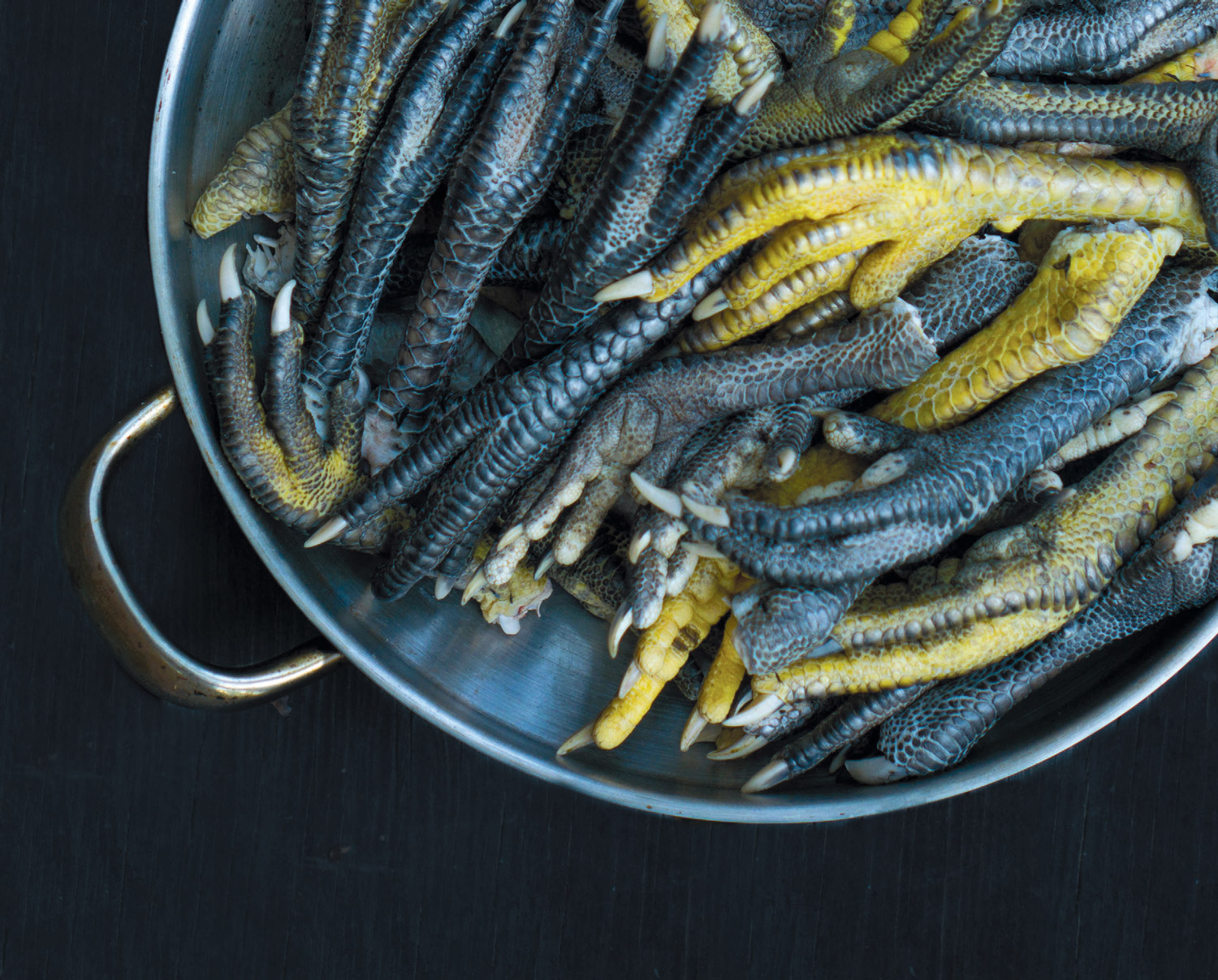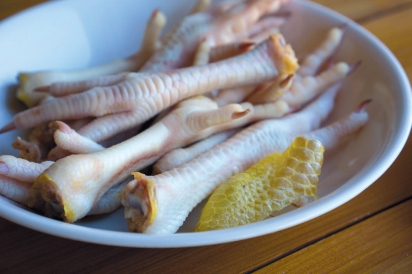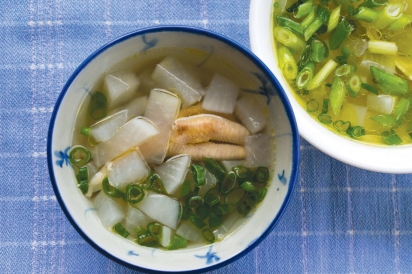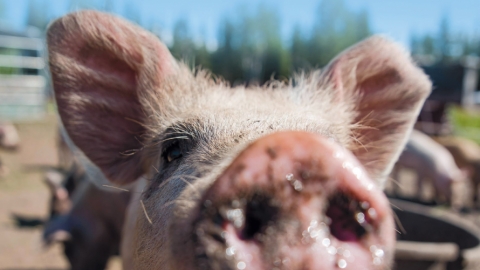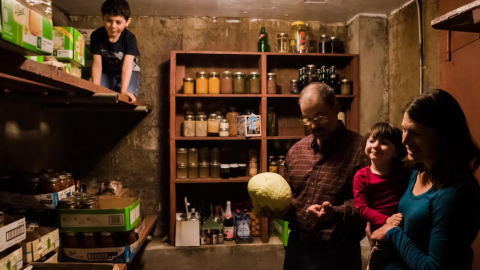Honor the Chicken: Eat the Feet
“Wait, is anyone going to keep those?” I asked, pointing at the silver-scaled appendages lying at the edge of the cleaning table. Eyebrows raised all around me. Feeling unusually confident, the words tumbled out before I could stop. “Could I please have them if no one else wants them?” The feet were so healthy looking, I jumped at the chance to keep them.
I had been visiting friends in Ester when their neighbor declared it was butchering day. A group of neighbors had raised a flock of chickens all summer, and it was time to dispatch them. Although I had never butchered a chicken before, I offered to assist. Our team of five processed around 35 birds. The three chicken owners put away their portion of the shiny pink carcasses. A local scientist happily hauled off the feathered skins for his lynx radio-collaring project. And I bounced home with a big bucket of chicken feet. Jackpot! I had no idea what to do with them, but I knew exactly how I wanted them to taste.
Growing up, I had seen chicken feet roll past me on dim sum carts in the Lower 48. The mysterious morsels were fried, sauced, and spectacularly savored by only one particular aunt who loved all foods. Few others in my family ate or even knew how to prepare chicken feet.
In college, chicken feet resurfaced when I read Natural Capitalism by Paul Hawken, Amory Lovins, and Hunter Lovins, a classic book on ecological economics. To highlight the leaders of environmental engineering and design, the authors credited Singaporean engineer Eng Lock Lee with mastering holistic systems design thinking. In response to praise for one of his designs, the authors quoted Mr. Lee: “Like Chinese cooking. Use everything. Eat the feet.” The phrase stayed with me as a guiding principle for the way I looked at and interacted with the systems around me. Recognizing strengths in unexpected places. Making connections. Two decades later, the gift of chicken feet came into my life to further my education on respecting the whole animal by fully utilizing and appreciating all it has to offer—in this case, learning how to cook and eat the feet.
Cultures around the world have rich traditions in preparing chicken feet, most notably Asia, eastern Europe, the Caribbean, and Africa. Packages of “chicken paws” can be found in grocery stores of the American South and at specialty butcher counters; however, paws tend to include the toes but not shanks. The chicken feet I received from my friends generously included all of the scaly part of the leg, which they cut off at the hock joint where the feathers end. Chicken feet add rich flavor, texture, and nutrition to a wide variety of dishes, especially as a substitute for the whole bird.
PROCESSING
In Alaska, meat chickens are raised and butchered in summer, so reach out to your chicken-rearing neighbors and friends early, and you might be able to score a bag of feet come butchering time. Thoroughly wash the feet in cold water. An old toothbrush or other abrasive tool can be used to remove debris. Inspect the feet for any sign of infection or wounds. Avoid cooking feet that are damaged or look infected, and notify the people who raised the chicken if you see anything that might need attention.
Birds are descendants of dinosaurs so the feet are covered by a tough outer layer of scaly skin. Colors vary depending on breed. This skin is often removed before cooking for both cleanliness and to avoid unpleasant flavor. Set up a blanching station with a source of simmering water, a bowl of ice water, a bowl for the scaly skin discards, and a bowl for the clean skins. Use tongs to immerse a foot into the simmering water for about 30 seconds and then immerse it briefly in the ice bath. When you are able to handle the foot with your hands, peel the scaly skin, starting from the hock joint and moving towards the toes. The outer nails may pop off with the skin, or you may remove the nails later with a knife. The scaly skin will come off more easily if it is not immersed in the hot water or ice water too long. Avoid immersion in hot water for too long because prolonged heat will cause the outer skin to bond to the inner skin underneath. Processing the feet right after butchering will make for smoother cleaning; however, this process will work also if you use thawed-out feet that have been previously frozen. If you opt to not process the feet right away, at least give them a good wash before freezing, then blanch and remove the outer skin before you prepare the dish.
MAKING STEWED CHICKEN FEET
When we were growing up, we had friends who had a restaurant. Because chicken wings were not popular pieces to eat at the time, the owners thoughtfully saved the unused chicken wings for us. They also gifted us pork bones for broth. This brothy stew is inspired by my parents’ home cooking.
Chicken feet include mostly skin, tendons, ligaments, and bone which contribute a flavor-packed combination of gelatin, collagen, vitamins, and minerals to the dish. Recipes abound for frying, steaming, braising, and otherwise celebrating the feet. I like to make a simple soup in a crockpot or on the stovetop. The feet are surprisingly filling, so 2–4 pieces could be a decent meal for one. The broth may become gelatinous when cooled and can be used for terrines. It will become liquid when heated again.
I cover chicken feet and fresh ginger in several inches of water and then bring them to a boil, then simmer on medium-low for several hours. The longer the chicken feet simmer, the softer the feet will become and the more collagen and flavor will go to the broth. When the feet are so soft that they nearly fall apart, I add daikon radish and simmer another 15–20 minutes, depending on how crunchy I’d like the daikon to be. Then I top with minced scallions and add soy sauce or salt to taste. You can also include your favorite veggies and herbs, chili oil, or noodles. Pro tip: keep a bowl nearby to collect bones as you eat the chicken feet.


